Strategic Analysis of Unilever: Business Landscape and Planning
VerifiedAdded on 2020/12/09
|15
|4515
|446
Report
AI Summary
This report provides a comprehensive analysis of Unilever's business landscape, encompassing its strategic planning, internal and external assessments, and competitive positioning. The report begins with an introduction to Unilever, a transnational consumer goods company, and explores its current strategic planning model, the Unilever Sustainable Living Plan (USLP). The study employs a three-stage approach, including strategy formulation, implementation, and evaluation. It then delves into external assessments, utilizing the External Factor Evaluation (EFE) Matrix and the Competitive Profile Matrix (CPM) to evaluate the company's competitive environment. Internal assessments, including SWOT analysis and the Internal Factor Evaluation (IFE) Matrix, are used to assess Unilever's strengths and weaknesses. The report further examines strategy formulation, considering alternative strategies and Porter's Five Generic Strategies. The Quantitative Strategic Planning Matrix (QSPM) is used for strategic analysis and choice. The analysis considers political, economic, social, technological, legal, and environmental factors impacting Unilever's performance. The report concludes by evaluating the impact of strategic planning on the organization's performance and offers insights into the company's strategic decision-making process. References are provided at the end of the report.
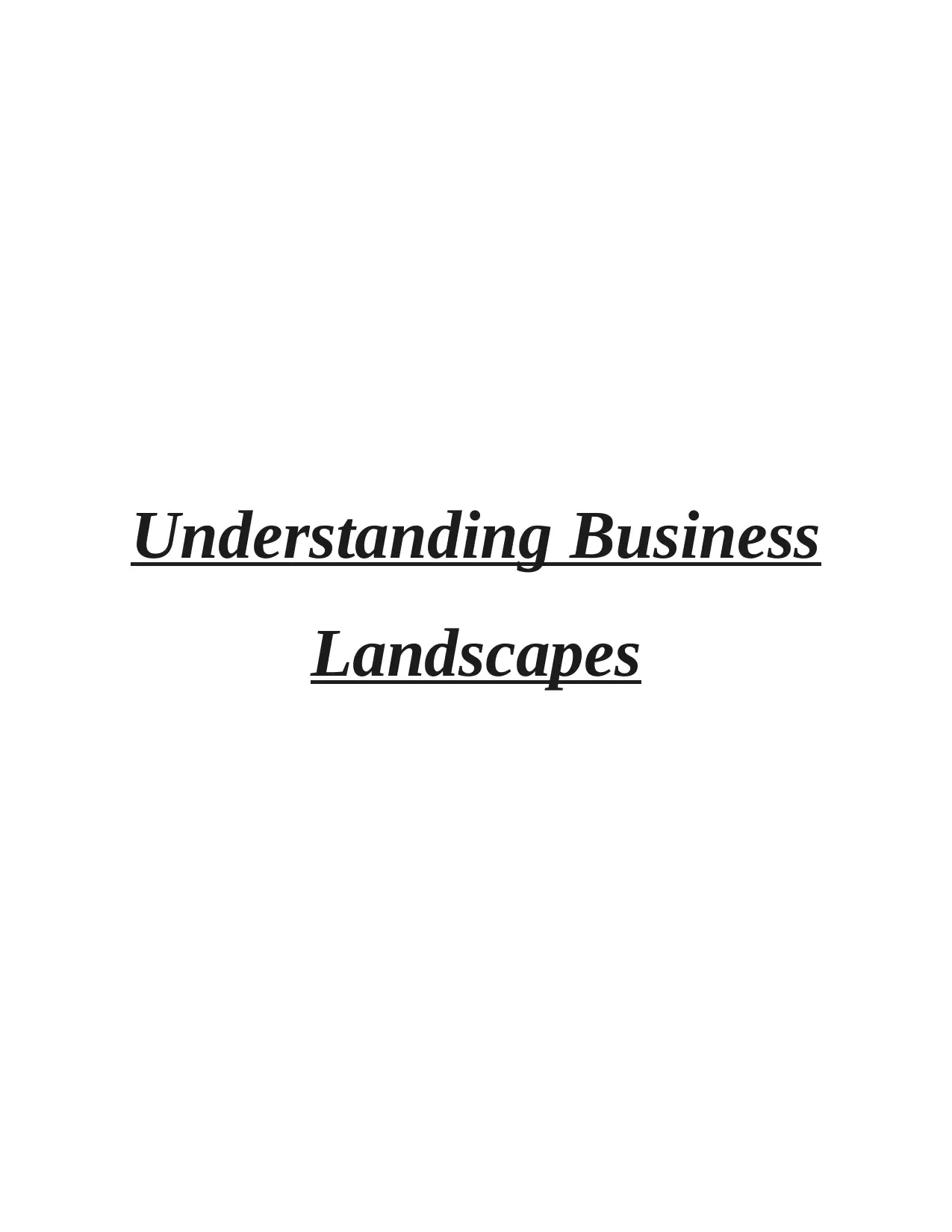
Understanding Business
Landscapes
Landscapes
Paraphrase This Document
Need a fresh take? Get an instant paraphrase of this document with our AI Paraphraser
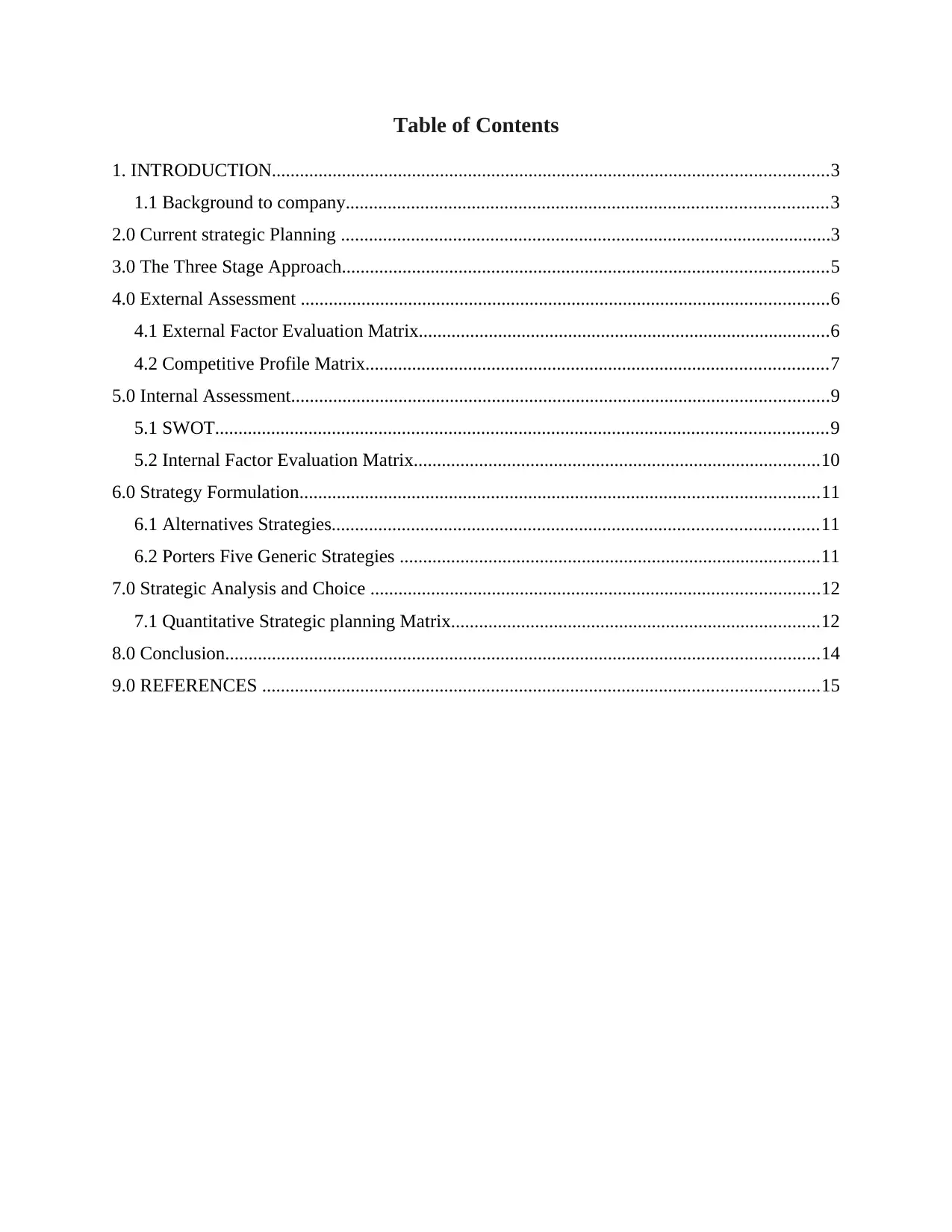
Table of Contents
1. INTRODUCTION.......................................................................................................................3
1.1 Background to company.......................................................................................................3
2.0 Current strategic Planning .........................................................................................................3
3.0 The Three Stage Approach........................................................................................................5
4.0 External Assessment .................................................................................................................6
4.1 External Factor Evaluation Matrix........................................................................................6
4.2 Competitive Profile Matrix...................................................................................................7
5.0 Internal Assessment...................................................................................................................9
5.1 SWOT...................................................................................................................................9
5.2 Internal Factor Evaluation Matrix.......................................................................................10
6.0 Strategy Formulation...............................................................................................................11
6.1 Alternatives Strategies........................................................................................................11
6.2 Porters Five Generic Strategies ..........................................................................................11
7.0 Strategic Analysis and Choice ................................................................................................12
7.1 Quantitative Strategic planning Matrix...............................................................................12
8.0 Conclusion...............................................................................................................................14
9.0 REFERENCES .......................................................................................................................15
1. INTRODUCTION.......................................................................................................................3
1.1 Background to company.......................................................................................................3
2.0 Current strategic Planning .........................................................................................................3
3.0 The Three Stage Approach........................................................................................................5
4.0 External Assessment .................................................................................................................6
4.1 External Factor Evaluation Matrix........................................................................................6
4.2 Competitive Profile Matrix...................................................................................................7
5.0 Internal Assessment...................................................................................................................9
5.1 SWOT...................................................................................................................................9
5.2 Internal Factor Evaluation Matrix.......................................................................................10
6.0 Strategy Formulation...............................................................................................................11
6.1 Alternatives Strategies........................................................................................................11
6.2 Porters Five Generic Strategies ..........................................................................................11
7.0 Strategic Analysis and Choice ................................................................................................12
7.1 Quantitative Strategic planning Matrix...............................................................................12
8.0 Conclusion...............................................................................................................................14
9.0 REFERENCES .......................................................................................................................15
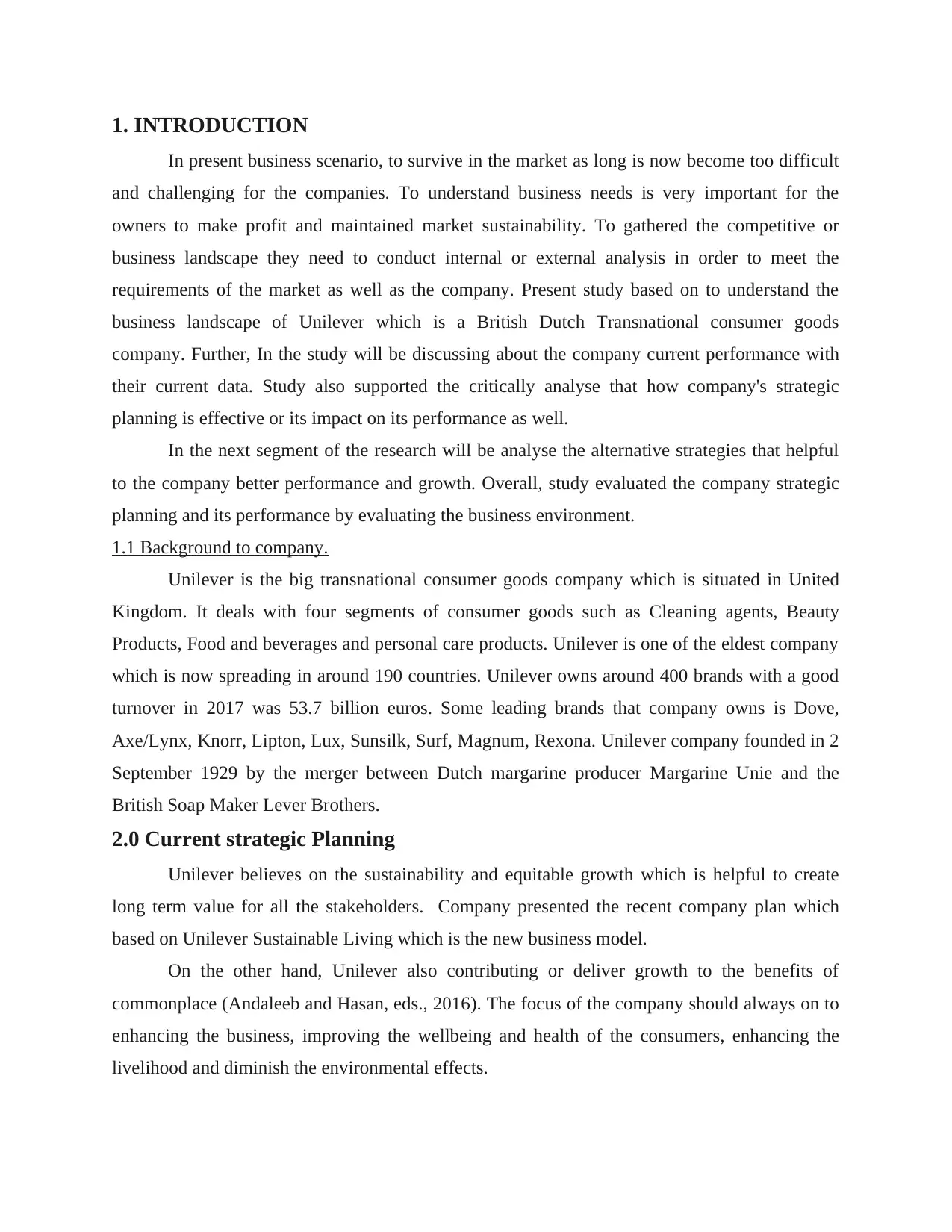
1. INTRODUCTION
In present business scenario, to survive in the market as long is now become too difficult
and challenging for the companies. To understand business needs is very important for the
owners to make profit and maintained market sustainability. To gathered the competitive or
business landscape they need to conduct internal or external analysis in order to meet the
requirements of the market as well as the company. Present study based on to understand the
business landscape of Unilever which is a British Dutch Transnational consumer goods
company. Further, In the study will be discussing about the company current performance with
their current data. Study also supported the critically analyse that how company's strategic
planning is effective or its impact on its performance as well.
In the next segment of the research will be analyse the alternative strategies that helpful
to the company better performance and growth. Overall, study evaluated the company strategic
planning and its performance by evaluating the business environment.
1.1 Background to company.
Unilever is the big transnational consumer goods company which is situated in United
Kingdom. It deals with four segments of consumer goods such as Cleaning agents, Beauty
Products, Food and beverages and personal care products. Unilever is one of the eldest company
which is now spreading in around 190 countries. Unilever owns around 400 brands with a good
turnover in 2017 was 53.7 billion euros. Some leading brands that company owns is Dove,
Axe/Lynx, Knorr, Lipton, Lux, Sunsilk, Surf, Magnum, Rexona. Unilever company founded in 2
September 1929 by the merger between Dutch margarine producer Margarine Unie and the
British Soap Maker Lever Brothers.
2.0 Current strategic Planning
Unilever believes on the sustainability and equitable growth which is helpful to create
long term value for all the stakeholders. Company presented the recent company plan which
based on Unilever Sustainable Living which is the new business model.
On the other hand, Unilever also contributing or deliver growth to the benefits of
commonplace (Andaleeb and Hasan, eds., 2016). The focus of the company should always on to
enhancing the business, improving the wellbeing and health of the consumers, enhancing the
livelihood and diminish the environmental effects.
In present business scenario, to survive in the market as long is now become too difficult
and challenging for the companies. To understand business needs is very important for the
owners to make profit and maintained market sustainability. To gathered the competitive or
business landscape they need to conduct internal or external analysis in order to meet the
requirements of the market as well as the company. Present study based on to understand the
business landscape of Unilever which is a British Dutch Transnational consumer goods
company. Further, In the study will be discussing about the company current performance with
their current data. Study also supported the critically analyse that how company's strategic
planning is effective or its impact on its performance as well.
In the next segment of the research will be analyse the alternative strategies that helpful
to the company better performance and growth. Overall, study evaluated the company strategic
planning and its performance by evaluating the business environment.
1.1 Background to company.
Unilever is the big transnational consumer goods company which is situated in United
Kingdom. It deals with four segments of consumer goods such as Cleaning agents, Beauty
Products, Food and beverages and personal care products. Unilever is one of the eldest company
which is now spreading in around 190 countries. Unilever owns around 400 brands with a good
turnover in 2017 was 53.7 billion euros. Some leading brands that company owns is Dove,
Axe/Lynx, Knorr, Lipton, Lux, Sunsilk, Surf, Magnum, Rexona. Unilever company founded in 2
September 1929 by the merger between Dutch margarine producer Margarine Unie and the
British Soap Maker Lever Brothers.
2.0 Current strategic Planning
Unilever believes on the sustainability and equitable growth which is helpful to create
long term value for all the stakeholders. Company presented the recent company plan which
based on Unilever Sustainable Living which is the new business model.
On the other hand, Unilever also contributing or deliver growth to the benefits of
commonplace (Andaleeb and Hasan, eds., 2016). The focus of the company should always on to
enhancing the business, improving the wellbeing and health of the consumers, enhancing the
livelihood and diminish the environmental effects.
⊘ This is a preview!⊘
Do you want full access?
Subscribe today to unlock all pages.

Trusted by 1+ million students worldwide
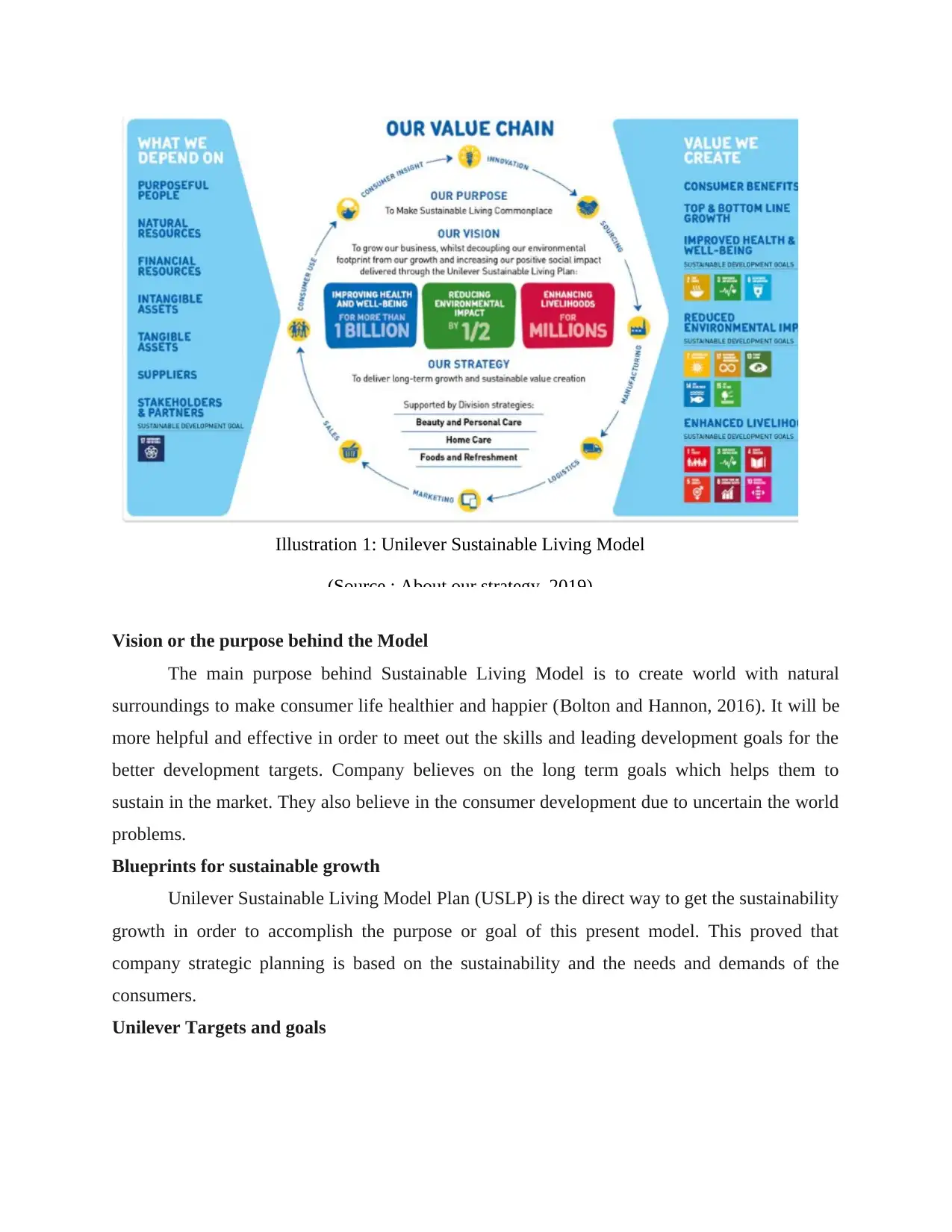
Vision or the purpose behind the Model
The main purpose behind Sustainable Living Model is to create world with natural
surroundings to make consumer life healthier and happier (Bolton and Hannon, 2016). It will be
more helpful and effective in order to meet out the skills and leading development goals for the
better development targets. Company believes on the long term goals which helps them to
sustain in the market. They also believe in the consumer development due to uncertain the world
problems.
Blueprints for sustainable growth
Unilever Sustainable Living Model Plan (USLP) is the direct way to get the sustainability
growth in order to accomplish the purpose or goal of this present model. This proved that
company strategic planning is based on the sustainability and the needs and demands of the
consumers.
Unilever Targets and goals
Illustration 1: Unilever Sustainable Living Model
(Source : About our strategy. 2019)
The main purpose behind Sustainable Living Model is to create world with natural
surroundings to make consumer life healthier and happier (Bolton and Hannon, 2016). It will be
more helpful and effective in order to meet out the skills and leading development goals for the
better development targets. Company believes on the long term goals which helps them to
sustain in the market. They also believe in the consumer development due to uncertain the world
problems.
Blueprints for sustainable growth
Unilever Sustainable Living Model Plan (USLP) is the direct way to get the sustainability
growth in order to accomplish the purpose or goal of this present model. This proved that
company strategic planning is based on the sustainability and the needs and demands of the
consumers.
Unilever Targets and goals
Illustration 1: Unilever Sustainable Living Model
(Source : About our strategy. 2019)
Paraphrase This Document
Need a fresh take? Get an instant paraphrase of this document with our AI Paraphraser
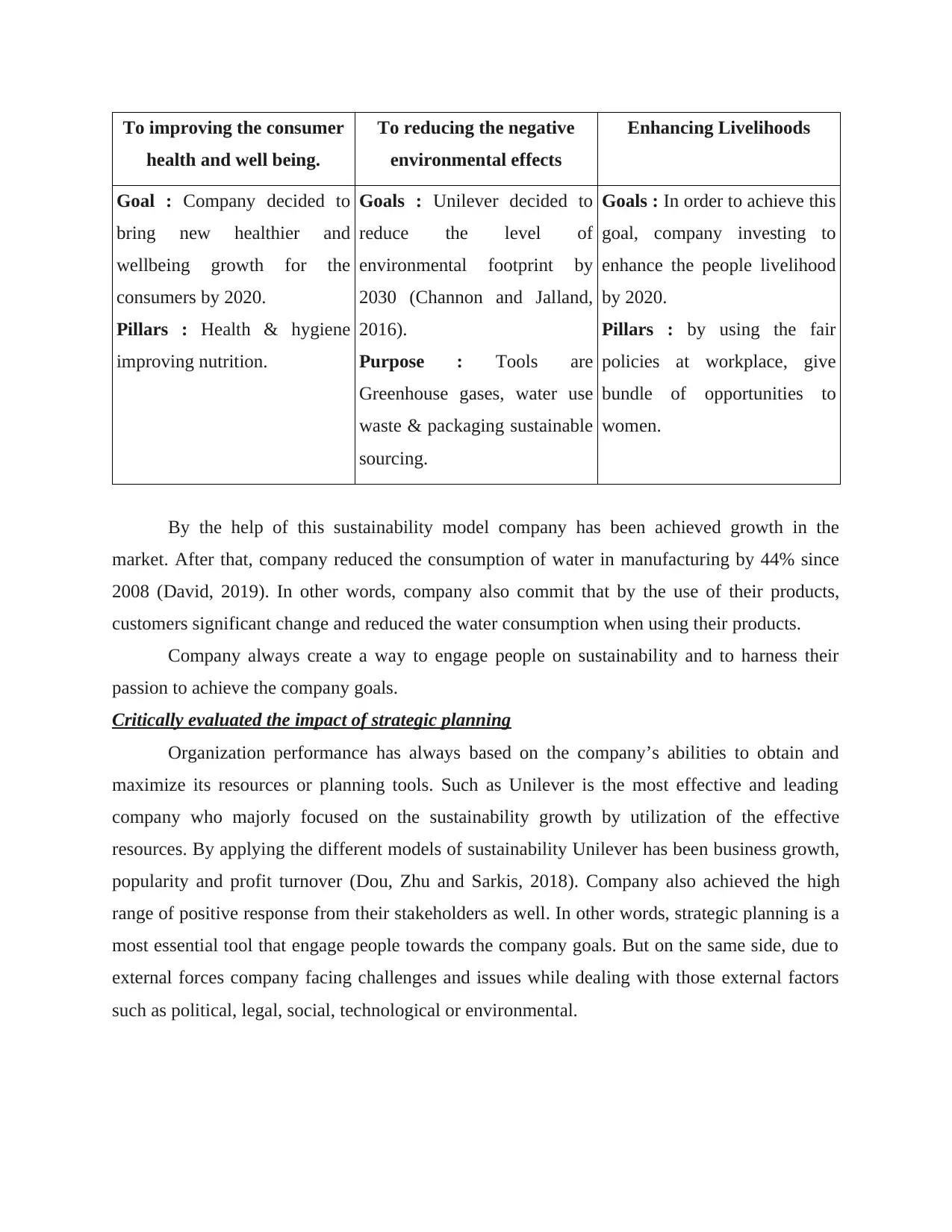
To improving the consumer
health and well being.
To reducing the negative
environmental effects
Enhancing Livelihoods
Goal : Company decided to
bring new healthier and
wellbeing growth for the
consumers by 2020.
Pillars : Health & hygiene
improving nutrition.
Goals : Unilever decided to
reduce the level of
environmental footprint by
2030 (Channon and Jalland,
2016).
Purpose : Tools are
Greenhouse gases, water use
waste & packaging sustainable
sourcing.
Goals : In order to achieve this
goal, company investing to
enhance the people livelihood
by 2020.
Pillars : by using the fair
policies at workplace, give
bundle of opportunities to
women.
By the help of this sustainability model company has been achieved growth in the
market. After that, company reduced the consumption of water in manufacturing by 44% since
2008 (David, 2019). In other words, company also commit that by the use of their products,
customers significant change and reduced the water consumption when using their products.
Company always create a way to engage people on sustainability and to harness their
passion to achieve the company goals.
Critically evaluated the impact of strategic planning
Organization performance has always based on the company’s abilities to obtain and
maximize its resources or planning tools. Such as Unilever is the most effective and leading
company who majorly focused on the sustainability growth by utilization of the effective
resources. By applying the different models of sustainability Unilever has been business growth,
popularity and profit turnover (Dou, Zhu and Sarkis, 2018). Company also achieved the high
range of positive response from their stakeholders as well. In other words, strategic planning is a
most essential tool that engage people towards the company goals. But on the same side, due to
external forces company facing challenges and issues while dealing with those external factors
such as political, legal, social, technological or environmental.
health and well being.
To reducing the negative
environmental effects
Enhancing Livelihoods
Goal : Company decided to
bring new healthier and
wellbeing growth for the
consumers by 2020.
Pillars : Health & hygiene
improving nutrition.
Goals : Unilever decided to
reduce the level of
environmental footprint by
2030 (Channon and Jalland,
2016).
Purpose : Tools are
Greenhouse gases, water use
waste & packaging sustainable
sourcing.
Goals : In order to achieve this
goal, company investing to
enhance the people livelihood
by 2020.
Pillars : by using the fair
policies at workplace, give
bundle of opportunities to
women.
By the help of this sustainability model company has been achieved growth in the
market. After that, company reduced the consumption of water in manufacturing by 44% since
2008 (David, 2019). In other words, company also commit that by the use of their products,
customers significant change and reduced the water consumption when using their products.
Company always create a way to engage people on sustainability and to harness their
passion to achieve the company goals.
Critically evaluated the impact of strategic planning
Organization performance has always based on the company’s abilities to obtain and
maximize its resources or planning tools. Such as Unilever is the most effective and leading
company who majorly focused on the sustainability growth by utilization of the effective
resources. By applying the different models of sustainability Unilever has been business growth,
popularity and profit turnover (Dou, Zhu and Sarkis, 2018). Company also achieved the high
range of positive response from their stakeholders as well. In other words, strategic planning is a
most essential tool that engage people towards the company goals. But on the same side, due to
external forces company facing challenges and issues while dealing with those external factors
such as political, legal, social, technological or environmental.
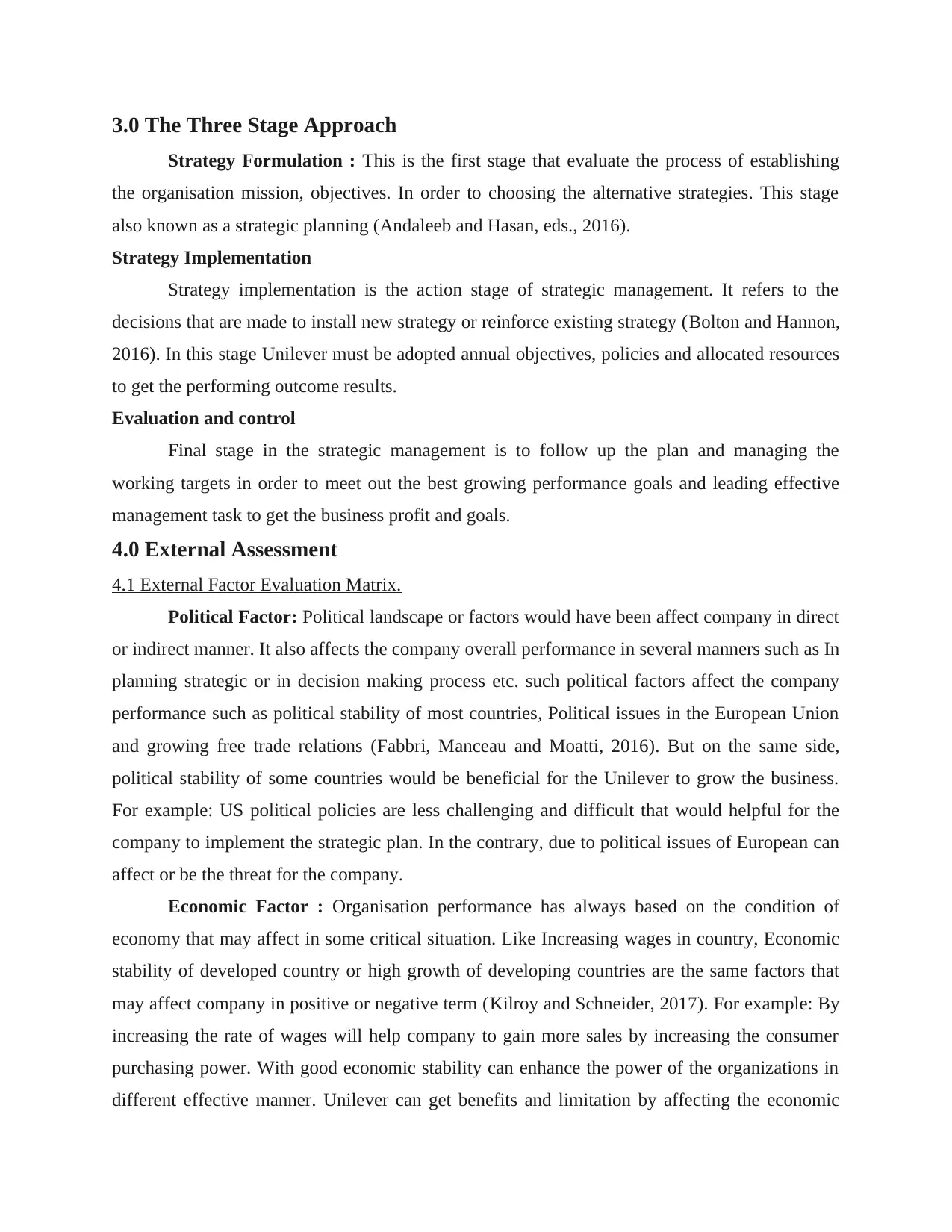
3.0 The Three Stage Approach
Strategy Formulation : This is the first stage that evaluate the process of establishing
the organisation mission, objectives. In order to choosing the alternative strategies. This stage
also known as a strategic planning (Andaleeb and Hasan, eds., 2016).
Strategy Implementation
Strategy implementation is the action stage of strategic management. It refers to the
decisions that are made to install new strategy or reinforce existing strategy (Bolton and Hannon,
2016). In this stage Unilever must be adopted annual objectives, policies and allocated resources
to get the performing outcome results.
Evaluation and control
Final stage in the strategic management is to follow up the plan and managing the
working targets in order to meet out the best growing performance goals and leading effective
management task to get the business profit and goals.
4.0 External Assessment
4.1 External Factor Evaluation Matrix.
Political Factor: Political landscape or factors would have been affect company in direct
or indirect manner. It also affects the company overall performance in several manners such as In
planning strategic or in decision making process etc. such political factors affect the company
performance such as political stability of most countries, Political issues in the European Union
and growing free trade relations (Fabbri, Manceau and Moatti, 2016). But on the same side,
political stability of some countries would be beneficial for the Unilever to grow the business.
For example: US political policies are less challenging and difficult that would helpful for the
company to implement the strategic plan. In the contrary, due to political issues of European can
affect or be the threat for the company.
Economic Factor : Organisation performance has always based on the condition of
economy that may affect in some critical situation. Like Increasing wages in country, Economic
stability of developed country or high growth of developing countries are the same factors that
may affect company in positive or negative term (Kilroy and Schneider, 2017). For example: By
increasing the rate of wages will help company to gain more sales by increasing the consumer
purchasing power. With good economic stability can enhance the power of the organizations in
different effective manner. Unilever can get benefits and limitation by affecting the economic
Strategy Formulation : This is the first stage that evaluate the process of establishing
the organisation mission, objectives. In order to choosing the alternative strategies. This stage
also known as a strategic planning (Andaleeb and Hasan, eds., 2016).
Strategy Implementation
Strategy implementation is the action stage of strategic management. It refers to the
decisions that are made to install new strategy or reinforce existing strategy (Bolton and Hannon,
2016). In this stage Unilever must be adopted annual objectives, policies and allocated resources
to get the performing outcome results.
Evaluation and control
Final stage in the strategic management is to follow up the plan and managing the
working targets in order to meet out the best growing performance goals and leading effective
management task to get the business profit and goals.
4.0 External Assessment
4.1 External Factor Evaluation Matrix.
Political Factor: Political landscape or factors would have been affect company in direct
or indirect manner. It also affects the company overall performance in several manners such as In
planning strategic or in decision making process etc. such political factors affect the company
performance such as political stability of most countries, Political issues in the European Union
and growing free trade relations (Fabbri, Manceau and Moatti, 2016). But on the same side,
political stability of some countries would be beneficial for the Unilever to grow the business.
For example: US political policies are less challenging and difficult that would helpful for the
company to implement the strategic plan. In the contrary, due to political issues of European can
affect or be the threat for the company.
Economic Factor : Organisation performance has always based on the condition of
economy that may affect in some critical situation. Like Increasing wages in country, Economic
stability of developed country or high growth of developing countries are the same factors that
may affect company in positive or negative term (Kilroy and Schneider, 2017). For example: By
increasing the rate of wages will help company to gain more sales by increasing the consumer
purchasing power. With good economic stability can enhance the power of the organizations in
different effective manner. Unilever can get benefits and limitation by affecting the economic
⊘ This is a preview!⊘
Do you want full access?
Subscribe today to unlock all pages.

Trusted by 1+ million students worldwide
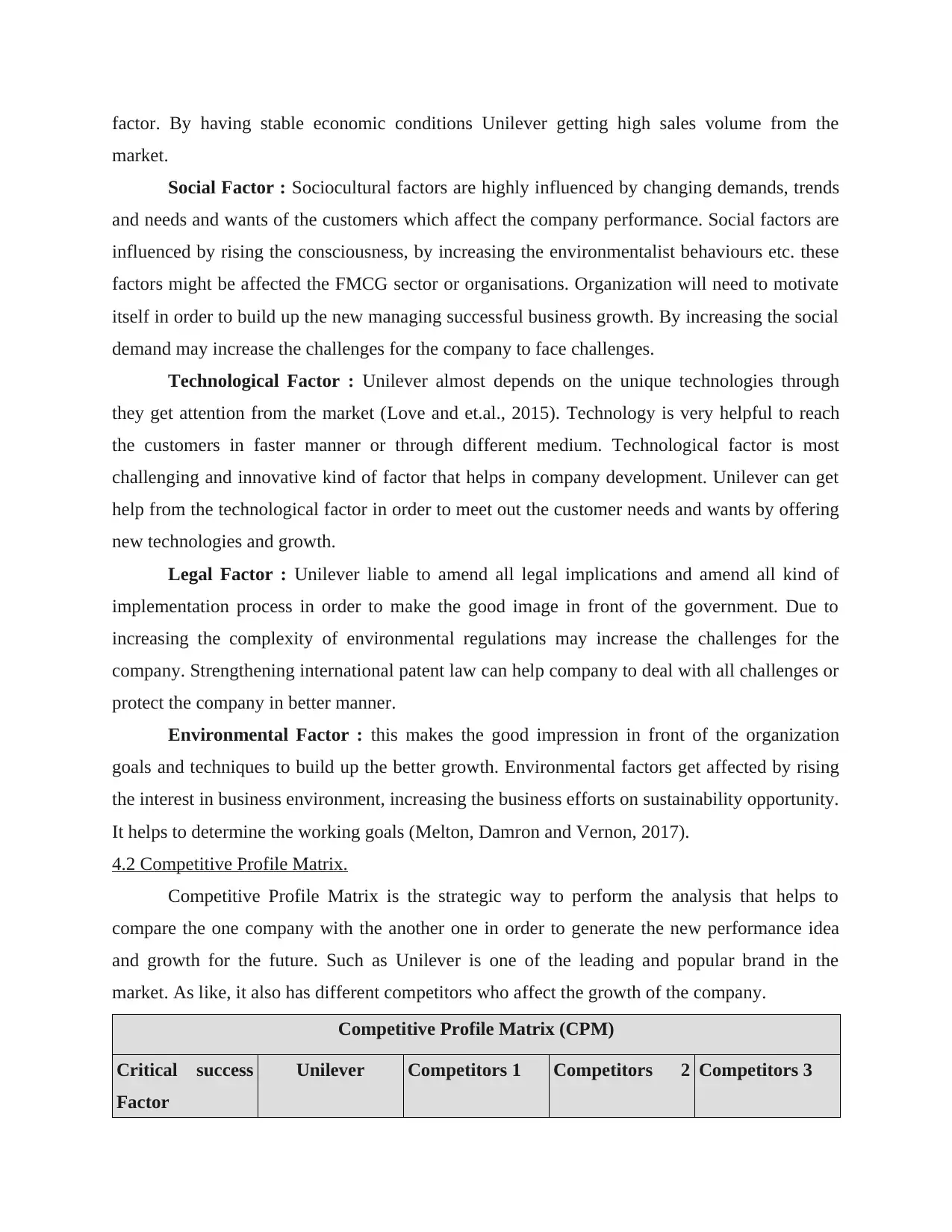
factor. By having stable economic conditions Unilever getting high sales volume from the
market.
Social Factor : Sociocultural factors are highly influenced by changing demands, trends
and needs and wants of the customers which affect the company performance. Social factors are
influenced by rising the consciousness, by increasing the environmentalist behaviours etc. these
factors might be affected the FMCG sector or organisations. Organization will need to motivate
itself in order to build up the new managing successful business growth. By increasing the social
demand may increase the challenges for the company to face challenges.
Technological Factor : Unilever almost depends on the unique technologies through
they get attention from the market (Love and et.al., 2015). Technology is very helpful to reach
the customers in faster manner or through different medium. Technological factor is most
challenging and innovative kind of factor that helps in company development. Unilever can get
help from the technological factor in order to meet out the customer needs and wants by offering
new technologies and growth.
Legal Factor : Unilever liable to amend all legal implications and amend all kind of
implementation process in order to make the good image in front of the government. Due to
increasing the complexity of environmental regulations may increase the challenges for the
company. Strengthening international patent law can help company to deal with all challenges or
protect the company in better manner.
Environmental Factor : this makes the good impression in front of the organization
goals and techniques to build up the better growth. Environmental factors get affected by rising
the interest in business environment, increasing the business efforts on sustainability opportunity.
It helps to determine the working goals (Melton, Damron and Vernon, 2017).
4.2 Competitive Profile Matrix.
Competitive Profile Matrix is the strategic way to perform the analysis that helps to
compare the one company with the another one in order to generate the new performance idea
and growth for the future. Such as Unilever is one of the leading and popular brand in the
market. As like, it also has different competitors who affect the growth of the company.
Competitive Profile Matrix (CPM)
Critical success
Factor
Unilever Competitors 1 Competitors 2 Competitors 3
market.
Social Factor : Sociocultural factors are highly influenced by changing demands, trends
and needs and wants of the customers which affect the company performance. Social factors are
influenced by rising the consciousness, by increasing the environmentalist behaviours etc. these
factors might be affected the FMCG sector or organisations. Organization will need to motivate
itself in order to build up the new managing successful business growth. By increasing the social
demand may increase the challenges for the company to face challenges.
Technological Factor : Unilever almost depends on the unique technologies through
they get attention from the market (Love and et.al., 2015). Technology is very helpful to reach
the customers in faster manner or through different medium. Technological factor is most
challenging and innovative kind of factor that helps in company development. Unilever can get
help from the technological factor in order to meet out the customer needs and wants by offering
new technologies and growth.
Legal Factor : Unilever liable to amend all legal implications and amend all kind of
implementation process in order to make the good image in front of the government. Due to
increasing the complexity of environmental regulations may increase the challenges for the
company. Strengthening international patent law can help company to deal with all challenges or
protect the company in better manner.
Environmental Factor : this makes the good impression in front of the organization
goals and techniques to build up the better growth. Environmental factors get affected by rising
the interest in business environment, increasing the business efforts on sustainability opportunity.
It helps to determine the working goals (Melton, Damron and Vernon, 2017).
4.2 Competitive Profile Matrix.
Competitive Profile Matrix is the strategic way to perform the analysis that helps to
compare the one company with the another one in order to generate the new performance idea
and growth for the future. Such as Unilever is one of the leading and popular brand in the
market. As like, it also has different competitors who affect the growth of the company.
Competitive Profile Matrix (CPM)
Critical success
Factor
Unilever Competitors 1 Competitors 2 Competitors 3
Paraphrase This Document
Need a fresh take? Get an instant paraphrase of this document with our AI Paraphraser
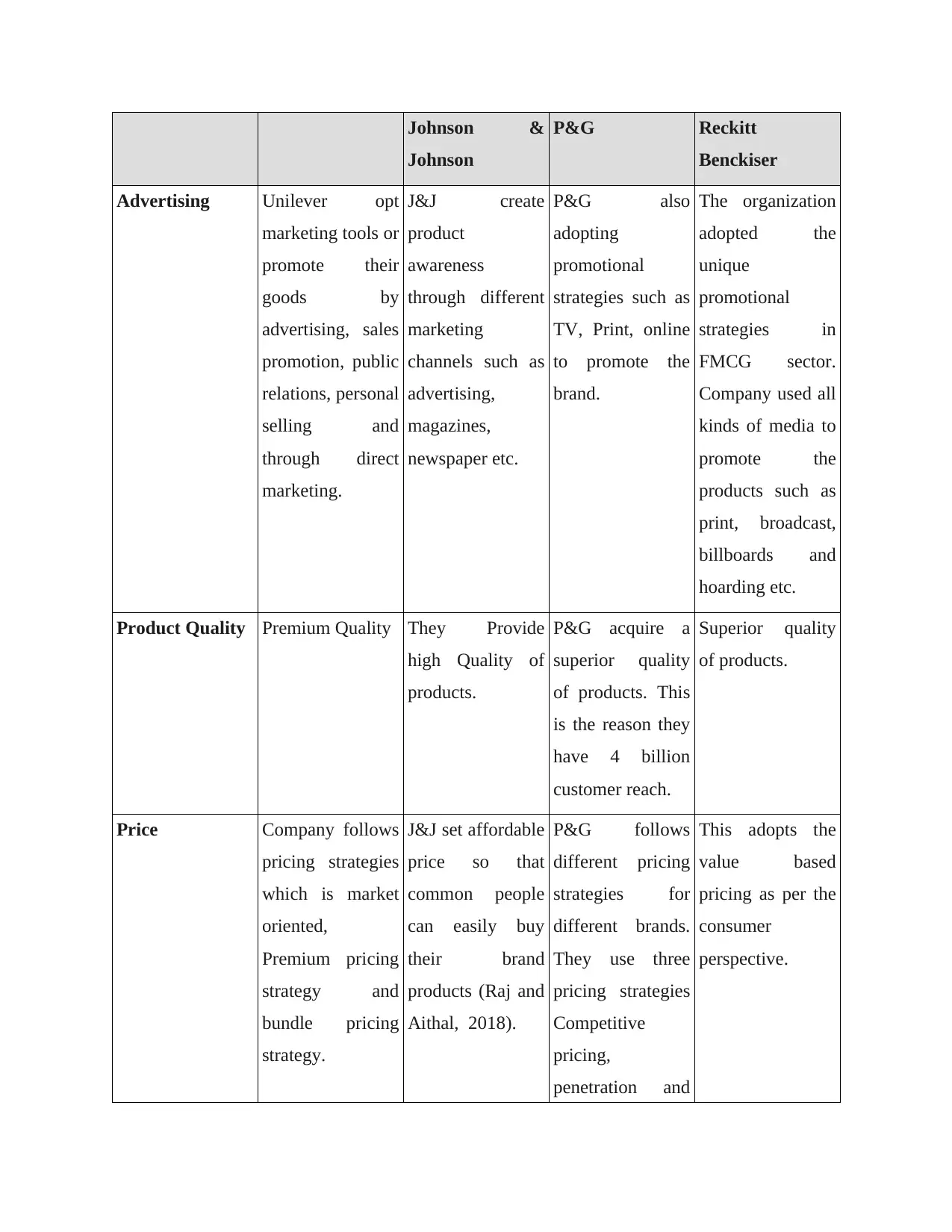
Johnson &
Johnson
P&G Reckitt
Benckiser
Advertising Unilever opt
marketing tools or
promote their
goods by
advertising, sales
promotion, public
relations, personal
selling and
through direct
marketing.
J&J create
product
awareness
through different
marketing
channels such as
advertising,
magazines,
newspaper etc.
P&G also
adopting
promotional
strategies such as
TV, Print, online
to promote the
brand.
The organization
adopted the
unique
promotional
strategies in
FMCG sector.
Company used all
kinds of media to
promote the
products such as
print, broadcast,
billboards and
hoarding etc.
Product Quality Premium Quality They Provide
high Quality of
products.
P&G acquire a
superior quality
of products. This
is the reason they
have 4 billion
customer reach.
Superior quality
of products.
Price Company follows
pricing strategies
which is market
oriented,
Premium pricing
strategy and
bundle pricing
strategy.
J&J set affordable
price so that
common people
can easily buy
their brand
products (Raj and
Aithal, 2018).
P&G follows
different pricing
strategies for
different brands.
They use three
pricing strategies
Competitive
pricing,
penetration and
This adopts the
value based
pricing as per the
consumer
perspective.
Johnson
P&G Reckitt
Benckiser
Advertising Unilever opt
marketing tools or
promote their
goods by
advertising, sales
promotion, public
relations, personal
selling and
through direct
marketing.
J&J create
product
awareness
through different
marketing
channels such as
advertising,
magazines,
newspaper etc.
P&G also
adopting
promotional
strategies such as
TV, Print, online
to promote the
brand.
The organization
adopted the
unique
promotional
strategies in
FMCG sector.
Company used all
kinds of media to
promote the
products such as
print, broadcast,
billboards and
hoarding etc.
Product Quality Premium Quality They Provide
high Quality of
products.
P&G acquire a
superior quality
of products. This
is the reason they
have 4 billion
customer reach.
Superior quality
of products.
Price Company follows
pricing strategies
which is market
oriented,
Premium pricing
strategy and
bundle pricing
strategy.
J&J set affordable
price so that
common people
can easily buy
their brand
products (Raj and
Aithal, 2018).
P&G follows
different pricing
strategies for
different brands.
They use three
pricing strategies
Competitive
pricing,
penetration and
This adopts the
value based
pricing as per the
consumer
perspective.
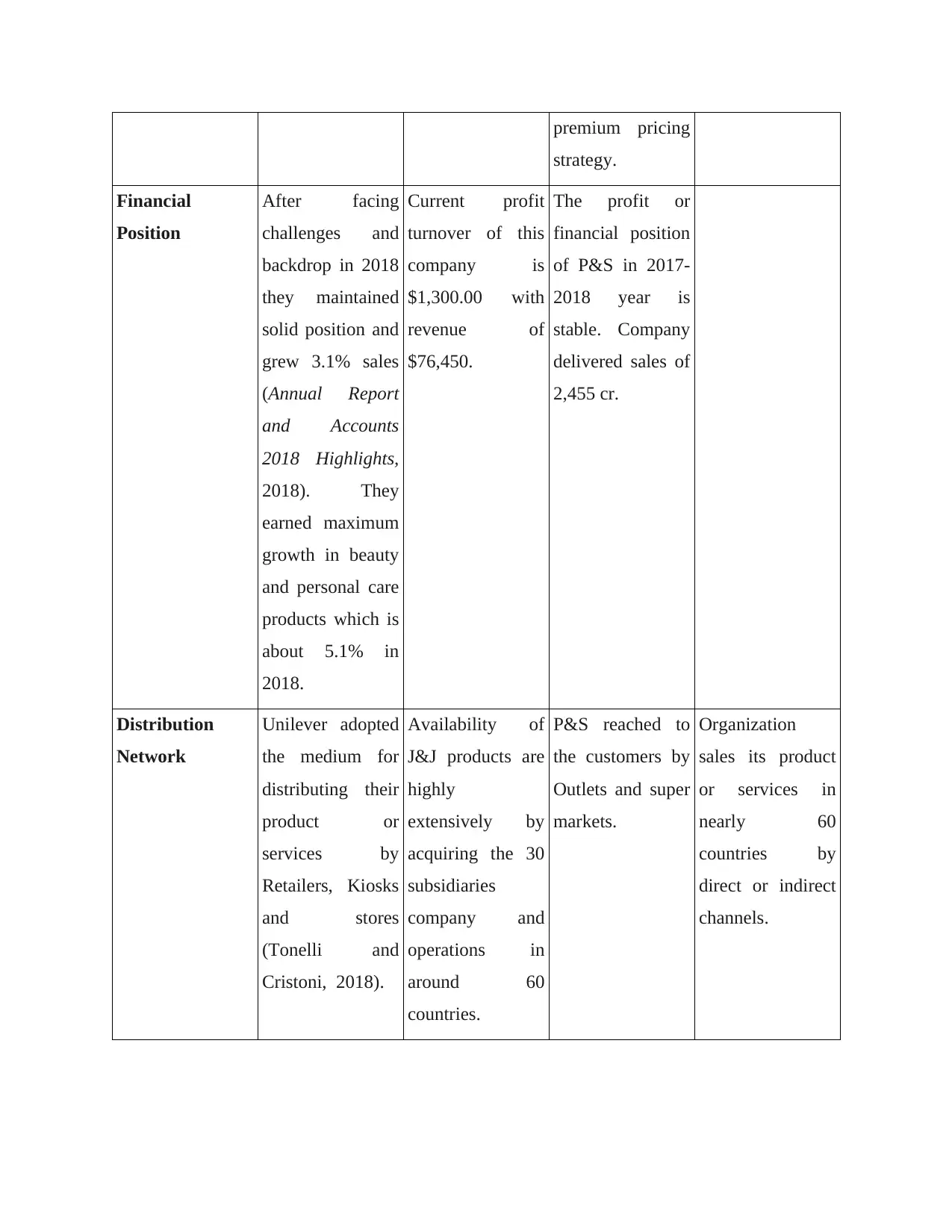
premium pricing
strategy.
Financial
Position
After facing
challenges and
backdrop in 2018
they maintained
solid position and
grew 3.1% sales
(Annual Report
and Accounts
2018 Highlights,
2018). They
earned maximum
growth in beauty
and personal care
products which is
about 5.1% in
2018.
Current profit
turnover of this
company is
$1,300.00 with
revenue of
$76,450.
The profit or
financial position
of P&S in 2017-
2018 year is
stable. Company
delivered sales of
2,455 cr.
Distribution
Network
Unilever adopted
the medium for
distributing their
product or
services by
Retailers, Kiosks
and stores
(Tonelli and
Cristoni, 2018).
Availability of
J&J products are
highly
extensively by
acquiring the 30
subsidiaries
company and
operations in
around 60
countries.
P&S reached to
the customers by
Outlets and super
markets.
Organization
sales its product
or services in
nearly 60
countries by
direct or indirect
channels.
strategy.
Financial
Position
After facing
challenges and
backdrop in 2018
they maintained
solid position and
grew 3.1% sales
(Annual Report
and Accounts
2018 Highlights,
2018). They
earned maximum
growth in beauty
and personal care
products which is
about 5.1% in
2018.
Current profit
turnover of this
company is
$1,300.00 with
revenue of
$76,450.
The profit or
financial position
of P&S in 2017-
2018 year is
stable. Company
delivered sales of
2,455 cr.
Distribution
Network
Unilever adopted
the medium for
distributing their
product or
services by
Retailers, Kiosks
and stores
(Tonelli and
Cristoni, 2018).
Availability of
J&J products are
highly
extensively by
acquiring the 30
subsidiaries
company and
operations in
around 60
countries.
P&S reached to
the customers by
Outlets and super
markets.
Organization
sales its product
or services in
nearly 60
countries by
direct or indirect
channels.
⊘ This is a preview!⊘
Do you want full access?
Subscribe today to unlock all pages.

Trusted by 1+ million students worldwide
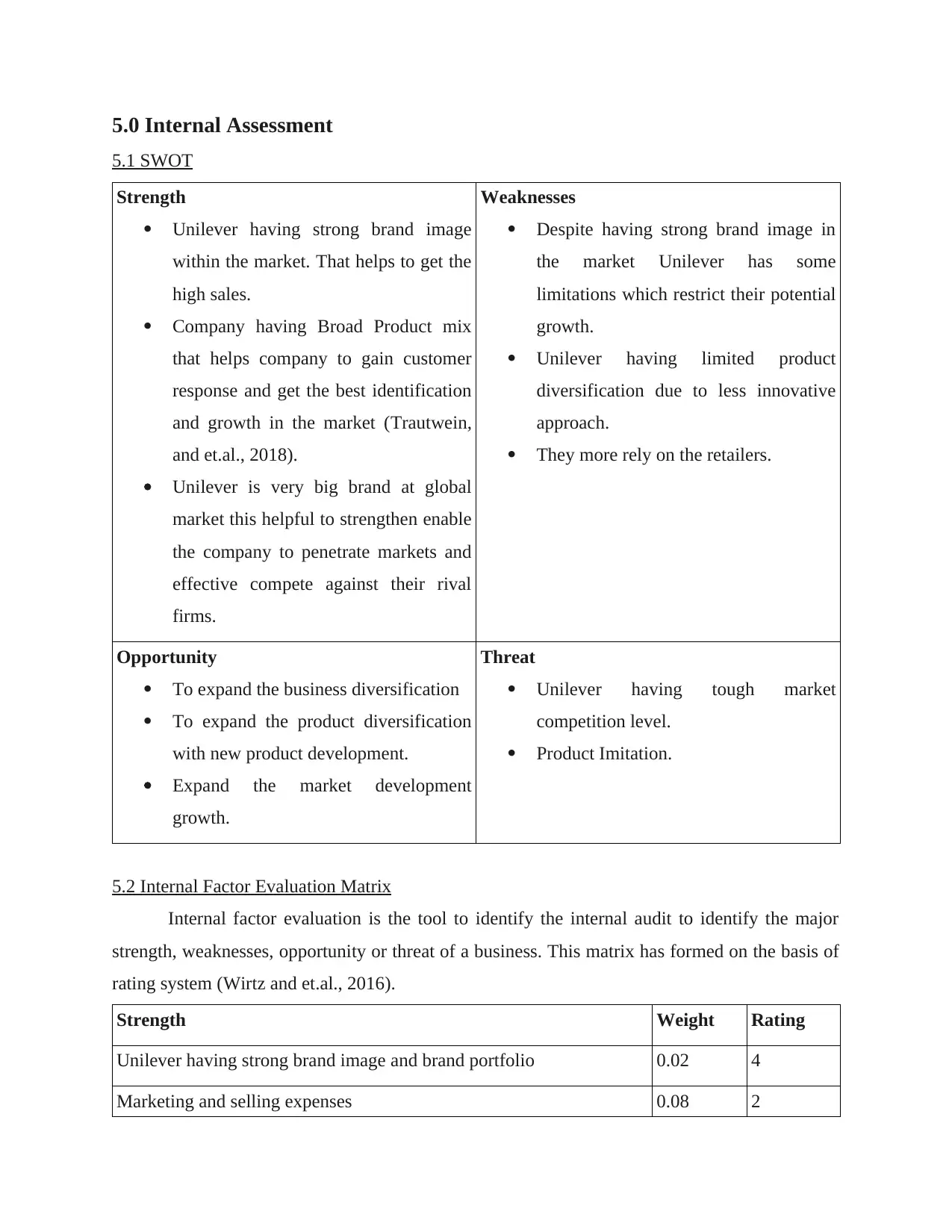
5.0 Internal Assessment
5.1 SWOT
Strength
Unilever having strong brand image
within the market. That helps to get the
high sales.
Company having Broad Product mix
that helps company to gain customer
response and get the best identification
and growth in the market (Trautwein,
and et.al., 2018).
Unilever is very big brand at global
market this helpful to strengthen enable
the company to penetrate markets and
effective compete against their rival
firms.
Weaknesses
Despite having strong brand image in
the market Unilever has some
limitations which restrict their potential
growth.
Unilever having limited product
diversification due to less innovative
approach.
They more rely on the retailers.
Opportunity
To expand the business diversification
To expand the product diversification
with new product development.
Expand the market development
growth.
Threat
Unilever having tough market
competition level.
Product Imitation.
5.2 Internal Factor Evaluation Matrix
Internal factor evaluation is the tool to identify the internal audit to identify the major
strength, weaknesses, opportunity or threat of a business. This matrix has formed on the basis of
rating system (Wirtz and et.al., 2016).
Strength Weight Rating
Unilever having strong brand image and brand portfolio 0.02 4
Marketing and selling expenses 0.08 2
5.1 SWOT
Strength
Unilever having strong brand image
within the market. That helps to get the
high sales.
Company having Broad Product mix
that helps company to gain customer
response and get the best identification
and growth in the market (Trautwein,
and et.al., 2018).
Unilever is very big brand at global
market this helpful to strengthen enable
the company to penetrate markets and
effective compete against their rival
firms.
Weaknesses
Despite having strong brand image in
the market Unilever has some
limitations which restrict their potential
growth.
Unilever having limited product
diversification due to less innovative
approach.
They more rely on the retailers.
Opportunity
To expand the business diversification
To expand the product diversification
with new product development.
Expand the market development
growth.
Threat
Unilever having tough market
competition level.
Product Imitation.
5.2 Internal Factor Evaluation Matrix
Internal factor evaluation is the tool to identify the internal audit to identify the major
strength, weaknesses, opportunity or threat of a business. This matrix has formed on the basis of
rating system (Wirtz and et.al., 2016).
Strength Weight Rating
Unilever having strong brand image and brand portfolio 0.02 4
Marketing and selling expenses 0.08 2
Paraphrase This Document
Need a fresh take? Get an instant paraphrase of this document with our AI Paraphraser
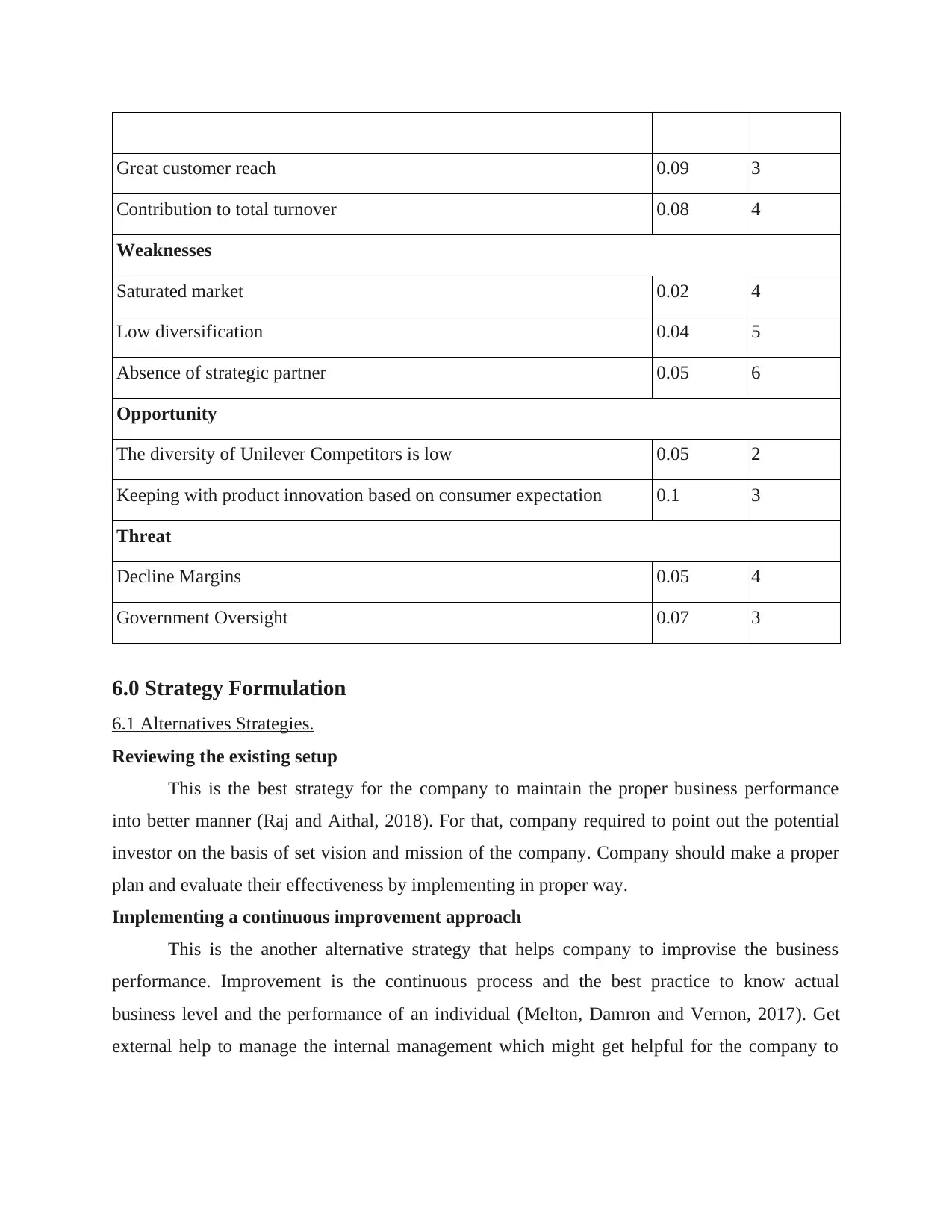
Great customer reach 0.09 3
Contribution to total turnover 0.08 4
Weaknesses
Saturated market 0.02 4
Low diversification 0.04 5
Absence of strategic partner 0.05 6
Opportunity
The diversity of Unilever Competitors is low 0.05 2
Keeping with product innovation based on consumer expectation 0.1 3
Threat
Decline Margins 0.05 4
Government Oversight 0.07 3
6.0 Strategy Formulation
6.1 Alternatives Strategies.
Reviewing the existing setup
This is the best strategy for the company to maintain the proper business performance
into better manner (Raj and Aithal, 2018). For that, company required to point out the potential
investor on the basis of set vision and mission of the company. Company should make a proper
plan and evaluate their effectiveness by implementing in proper way.
Implementing a continuous improvement approach
This is the another alternative strategy that helps company to improvise the business
performance. Improvement is the continuous process and the best practice to know actual
business level and the performance of an individual (Melton, Damron and Vernon, 2017). Get
external help to manage the internal management which might get helpful for the company to
Contribution to total turnover 0.08 4
Weaknesses
Saturated market 0.02 4
Low diversification 0.04 5
Absence of strategic partner 0.05 6
Opportunity
The diversity of Unilever Competitors is low 0.05 2
Keeping with product innovation based on consumer expectation 0.1 3
Threat
Decline Margins 0.05 4
Government Oversight 0.07 3
6.0 Strategy Formulation
6.1 Alternatives Strategies.
Reviewing the existing setup
This is the best strategy for the company to maintain the proper business performance
into better manner (Raj and Aithal, 2018). For that, company required to point out the potential
investor on the basis of set vision and mission of the company. Company should make a proper
plan and evaluate their effectiveness by implementing in proper way.
Implementing a continuous improvement approach
This is the another alternative strategy that helps company to improvise the business
performance. Improvement is the continuous process and the best practice to know actual
business level and the performance of an individual (Melton, Damron and Vernon, 2017). Get
external help to manage the internal management which might get helpful for the company to
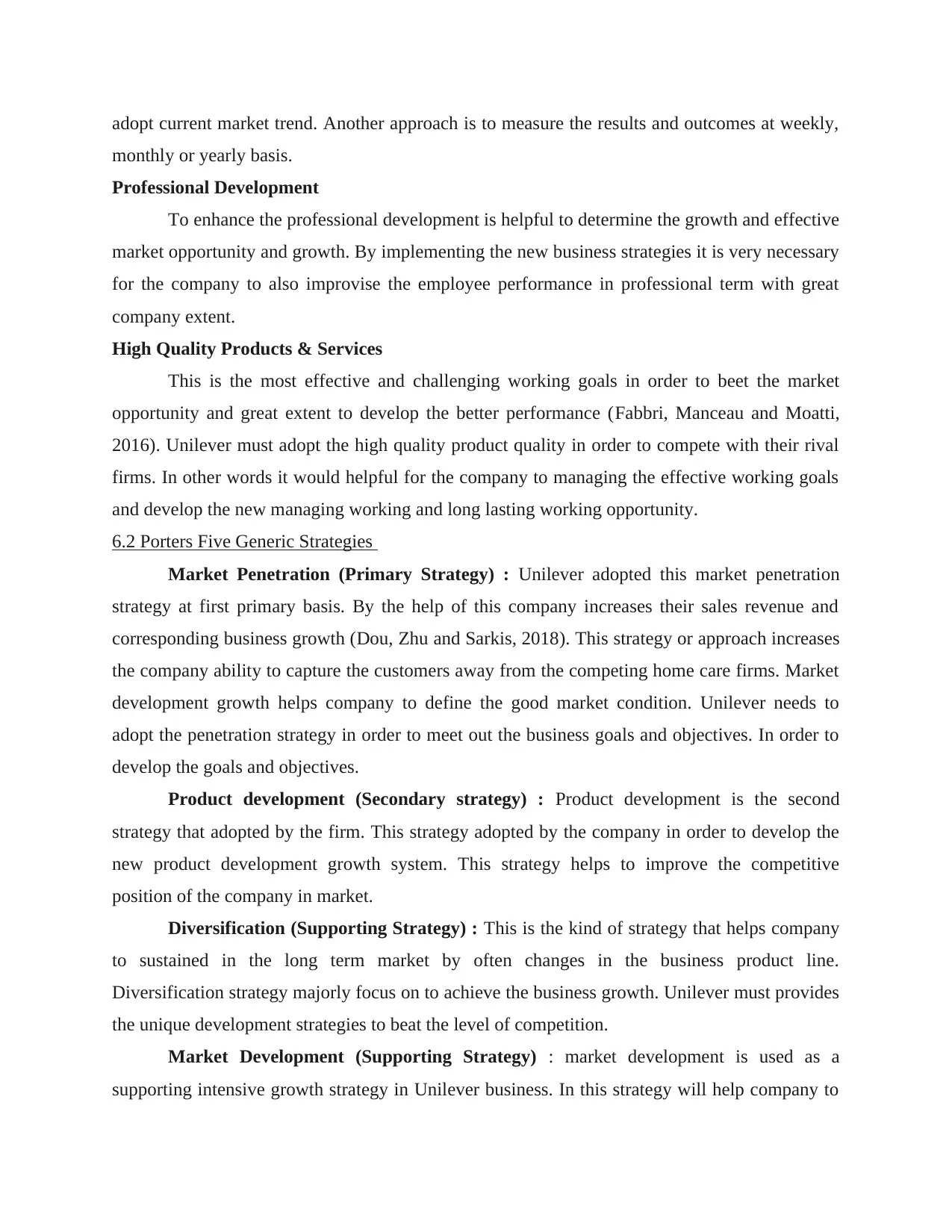
adopt current market trend. Another approach is to measure the results and outcomes at weekly,
monthly or yearly basis.
Professional Development
To enhance the professional development is helpful to determine the growth and effective
market opportunity and growth. By implementing the new business strategies it is very necessary
for the company to also improvise the employee performance in professional term with great
company extent.
High Quality Products & Services
This is the most effective and challenging working goals in order to beet the market
opportunity and great extent to develop the better performance (Fabbri, Manceau and Moatti,
2016). Unilever must adopt the high quality product quality in order to compete with their rival
firms. In other words it would helpful for the company to managing the effective working goals
and develop the new managing working and long lasting working opportunity.
6.2 Porters Five Generic Strategies
Market Penetration (Primary Strategy) : Unilever adopted this market penetration
strategy at first primary basis. By the help of this company increases their sales revenue and
corresponding business growth (Dou, Zhu and Sarkis, 2018). This strategy or approach increases
the company ability to capture the customers away from the competing home care firms. Market
development growth helps company to define the good market condition. Unilever needs to
adopt the penetration strategy in order to meet out the business goals and objectives. In order to
develop the goals and objectives.
Product development (Secondary strategy) : Product development is the second
strategy that adopted by the firm. This strategy adopted by the company in order to develop the
new product development growth system. This strategy helps to improve the competitive
position of the company in market.
Diversification (Supporting Strategy) : This is the kind of strategy that helps company
to sustained in the long term market by often changes in the business product line.
Diversification strategy majorly focus on to achieve the business growth. Unilever must provides
the unique development strategies to beat the level of competition.
Market Development (Supporting Strategy) : market development is used as a
supporting intensive growth strategy in Unilever business. In this strategy will help company to
monthly or yearly basis.
Professional Development
To enhance the professional development is helpful to determine the growth and effective
market opportunity and growth. By implementing the new business strategies it is very necessary
for the company to also improvise the employee performance in professional term with great
company extent.
High Quality Products & Services
This is the most effective and challenging working goals in order to beet the market
opportunity and great extent to develop the better performance (Fabbri, Manceau and Moatti,
2016). Unilever must adopt the high quality product quality in order to compete with their rival
firms. In other words it would helpful for the company to managing the effective working goals
and develop the new managing working and long lasting working opportunity.
6.2 Porters Five Generic Strategies
Market Penetration (Primary Strategy) : Unilever adopted this market penetration
strategy at first primary basis. By the help of this company increases their sales revenue and
corresponding business growth (Dou, Zhu and Sarkis, 2018). This strategy or approach increases
the company ability to capture the customers away from the competing home care firms. Market
development growth helps company to define the good market condition. Unilever needs to
adopt the penetration strategy in order to meet out the business goals and objectives. In order to
develop the goals and objectives.
Product development (Secondary strategy) : Product development is the second
strategy that adopted by the firm. This strategy adopted by the company in order to develop the
new product development growth system. This strategy helps to improve the competitive
position of the company in market.
Diversification (Supporting Strategy) : This is the kind of strategy that helps company
to sustained in the long term market by often changes in the business product line.
Diversification strategy majorly focus on to achieve the business growth. Unilever must provides
the unique development strategies to beat the level of competition.
Market Development (Supporting Strategy) : market development is used as a
supporting intensive growth strategy in Unilever business. In this strategy will help company to
⊘ This is a preview!⊘
Do you want full access?
Subscribe today to unlock all pages.

Trusted by 1+ million students worldwide
1 out of 15
Related Documents
Your All-in-One AI-Powered Toolkit for Academic Success.
+13062052269
info@desklib.com
Available 24*7 on WhatsApp / Email
![[object Object]](/_next/static/media/star-bottom.7253800d.svg)
Unlock your academic potential
Copyright © 2020–2025 A2Z Services. All Rights Reserved. Developed and managed by ZUCOL.





